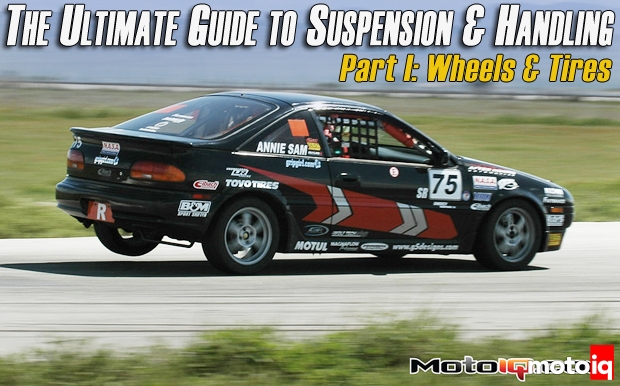,
Race compound DOT tires produce more road sucking grip than any suspension mod you can do but the drawbacks are many. First, these tires can be expensive; second, they wear quickly; third, the number of heat cycles that their rubber formulations can withstand before becoming oxidized and hard is limited; and fourth, many of them don’t do well in the wet and none work in the snow or ice. It is possible to end up with an expensive, fast wearing and not so grippy tire if these race tires are used on the street and subjected to many heat cycles. Most people who use these race tires have a second set of wheels and use them only for weekend warrior activities.

Within reason, put a wider wheel and tire on your car to put more rubber on the road. Generally you can stuff a tire two sizes larger than stock into most cars stock wheel wells. For instance a car that came with a 185/70-14 tire on a 5″ inch wide wheel can usually easily accommodate a 205/50-15 on a 7″ wide wheel with no modifications at all. On most cars you can roll the fender flange flat to get more tire clearance if needed. Do not accept any rubbing between the tire and any part of the car, be it the fender or the suspension, it can be very dangerous. When deciding which wider wheels for your car, try to stick to close to the stock proportions of offset to wheel width to maintain a reasonable scrub radius. We will explain why in later editions of our handling guide. Choose the size of your tire and wheel including the offset with this in mind for the best performance rather than going for the hella flush aesthetic unless that’s what floats your boat.
 |
|
For all of our poking fun of Hella Flush, and overstreching tires on too wide wheels, stretching tires can improve response by making it harder to get sidewall flex under cornering load. Here the Cyber EVO, one of the fastest time attack cars ever built shows its stretched tires. For road racing we feel that this is not advisable due to the sensitivity to impact damage and de-beading if things are not exactly right but the Cyber EVO shows that this technique can work well. It is a trick that some autocrossers swear by as they need fast response.
|
Putting the tires on a wheel of the recommended width for the tire is important as well. Putting a wide tire on a narrow stock rim will cause the tread to tend to lift on the edges under side load. If you can’t get the exact wheel width recommended by the tire manufacturer for your size of tire, then always err to the wider side if you have the choice. A tire that is slightly stretched on a wide wheel will be more responsive and flex less under side load than one whose sidewalls are bubbled due to too narrow of a rim. Some autocrossers looking for the maximum responsiveness out of their tires will stretch a tire on a rim as much as two inches too wide. When doing this, the rim and tire are more prone to damage and debeading under impact so this is not advisable for street use or road racing where you sometimes put wheels off the track or hit FIA curbs.
 |
|
It's obvious that this isn't the greatest thing for performance.
|
Plus sizing, which is going to a larger diameter wheel and a low profile tire can help with faster response to steering input and less need for static negative camber for best grip due to the plus tires having a shorter and stiffer sidewall. For instance going from a 205/55-15 to a 205/40-17 on your typical FWD compact car will usually give crisper handling. Going overboard like several inches larger in your rim diameter and running ultra low profile tires generally is not always the hot tip.
 |
|
Overstretched tires are prone to de-beading and damage to the tire and wheel from impact, wrong inflation pressure and side load.
|




12 comments
Hi.. This is a very informative article. Thanks for writing it. I am a student trying to learn about vehicle dynamics. I have a doubt in this article… When the example of the monster truck is given regarding the weight of the unsprung mass, the statement “For the suspension to work well, the ratio of sprung to unsprung weight must be kept as low as possible” seems contradictory. Is this a mistake or have I misunderstood it?
If the tire’s weight is high, the suspension doesn’t work well.
Ok.. Thanks
Thank you so much Mike,
For sharing those precious informations. I’m a racer and I’m actually setting up a Nissan Sentra B13 that’s powered by an SR20VE with N1 cams coupled to an SR16VE transmission. I’m debating on using 17″ wheels with 225/50/17 or 15″wheels with 205/50/15.
The track is 2.3km long with lots of in field sections and only 2 straight lines basically, one of 250 meters and the other one is 400 meters.
I’m racing against a bunch of Honda civics with B20 engines.
Now, with the 17″ setup, the car will sit higher to the ground compared to the 15″, but the tires are wider. The shorter gearing ratio with the 15″ should be a plus for acceleration, but the extra grip of the 17″ from my understanding should be better for braking and turning. The 15″ are lighter so less unsprung weight.
Sorry for the long and detailed post but I really need your input.
Thank you.
Since there are no optional gear ratios for the Nissan transmission, it’s 15″ wheels unless you are running slicks and need more brake. Your track might not be too hard on brakes.
Thanks Mike,
we are using street tires for the class I’m racing. So you don’t think that the extra grip provided by the wider 225/50/17 tires would make a big difference when braking and turning on that track compared to the 205/50/15?
Why don’t you run wider 15″s?
The class doesn’t allow wider 15″s.
Well that sucks.
Hi Mike, I am a student, I am curious to know if there is an ideal sprung to unsprung mass ratio that works well.
You want the unsprung weight to be as low as posible.
Hola. Cuál es la mejor opción para un Susuki Swift Sport que trae de fabrica unas 195/45/17: cambiarlas a 215/45/17 o 215/40/17